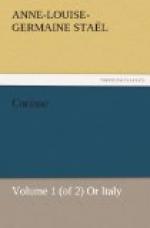“Your terrible Shakespeare, my lord,” continued Corinne, “has furnished the subject of the third dramatic picture—it is Macbeth,—the invincible Macbeth—who, ready to fight Macduff, whose wife and children he has put to death, learns that the oracle of the witches is accomplished, that Birnam Wood is advancing to Dunsinane, and that he is fighting a man who was born after the death of his mother. Macbeth is conquered by fate, but not by his adversary.—He grasps the sword with a desperate hand;—he knows that he is about to die;—but wishes to try whether human strength cannot triumph over destiny. There is certainly in this head, a fine expression of wildness and fury—of trouble and of energy; but how many poetical beauties do we miss? Is it possible to paint Macbeth plunged in guilt by the spells of ambition, which offer themselves to him under the shape of witchcraft? How can painting express the terror which he feels? That terror, however, which is not inconsistent with intrepid bravery? Is it possible to characterise that peculiar species of superstition which oppresses him? That belief without dignity, that hell-born fatality which weighs him down, his contempt of life, his horror of death? Undoubtedly the human countenance is the greatest of mysteries; but the motionless physiognomy of a painting can never express more than the workings of a single sentiment. Contrasts, conflicts of the mind, events, in short, belong to the dramatic art. Painting can with difficulty render a succession of events: time and movement exist not for it.




